
This is Lena.
One of the hardest parts of genealogy is all the things you can never know. Of all the facts I know about Lena — her birth, marriage, and death dates, her children, her livelihood, where she lived in 1920, 1930, 1940 — I still know very little about what she was like. When we recently got a chance to meet one of her nephews (now ninety years old), his stories were invaluable.
Lena didn’t have a terribly easy life. She immigrated to Chicago from a small Ukranian shtetl in the early twentieth century to keep house for her father and brothers (after her older sisters all got married). Once she herself got married, her husband was a “skirt hound” who lost his job for gambling his milk route money instead of returning it to the dairy. She ran a candy store for decades, while raising four children; this becomes more impressive in context of the unemployed gambling spouse and the Great Depression. She eventually died of some combination of diabetes, Alzheimers, and cancer that led to heart failure. But what stood out for me in her nephew’s memories most was the fact that whenever somebody visited, she “always had a pan of salami frying in chicken fat, and a big pot of coffee on the stove.” (And just to be clear, that isn’t a coffeepot of coffee. It’s a pot of coffee. A stewpot, in fact.)
So today’s retro recipe was never written down anywhere, and is quite a departure from our typical corporate-based recipe weirdness.
Chicken fat — or, in Lena’s native Yiddish, schmaltz — was the traditional kosher fat (before Crisco came along). It’s almost impossible to find commercially nowadays; Google “buy schmaltz” and the first page of results is just other people asking “where can I buy schmaltz,” no actual stores.
Making your own is difficult, not because of the rendering process (remember when we made lard? it’s that easy) but because you need a lot of chicken skin to cook down. I’ve generally gotten about one cup of fat from four cups of skin, and so even saving (and freezing) all the scraps of skin every time we make chicken, it takes a while to get enough to be worth rendering. I’ve actually started buying bone-in, skin-on chicken breasts and deboning them myself; they’re cheaper per pound, the skin turns into schmaltz, and the bones and scraps turn into chicken stock.
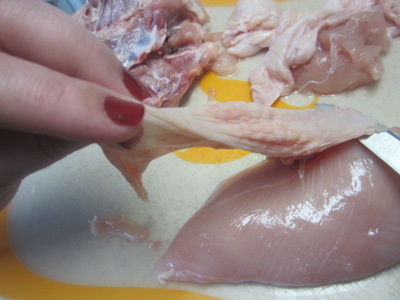
This generally leads to a long discussion of where exactly all this schmaltz was coming from back in the day, because considering how many chickens it takes to get a moderate amount of schmaltz — that’s an awful lot of poultry to be able to cook regularly. Or maybe chickens were just very fat a hundred years ago.
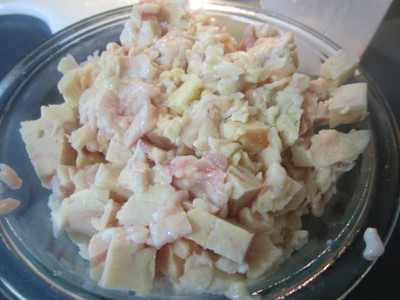
Lots of chopped up chicken skin, into the pot.
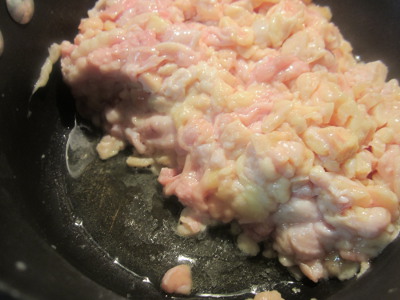
After a few minutes, it’s already starting to glisten.
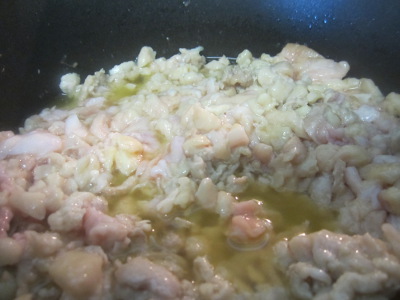
After a few more, it’s starting to swim. See that golden puddle?
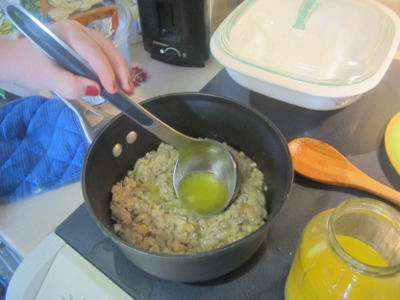
I usually give a batch this size a good twenty minutes to release as much fat as possible. When the skins are all shriveled up and browned, you’ve made grebenes (the chicken version of pork cracklin’), and a big puddle of schmaltz. (If you want to eat the grebenes, feel free, just salt them well and don’t tell your cardiologist. Also, wait for most of the schmaltz to run off before trying one, because they taste a lot better when they’re not soaking in grease… ironically.)
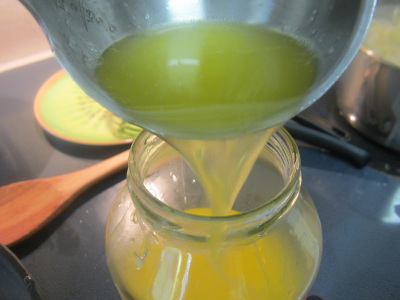
The schmaltz can go in a jar and be refrigerated for quite some time.
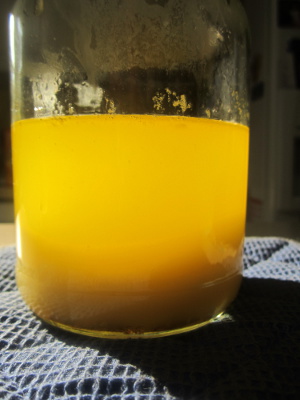
I like schmaltz better than lard because it’s just so pretty — in fact, it looks much like butter. (Which brings to mind schmaltz pie crusts — I’ve gotta try that some day.)
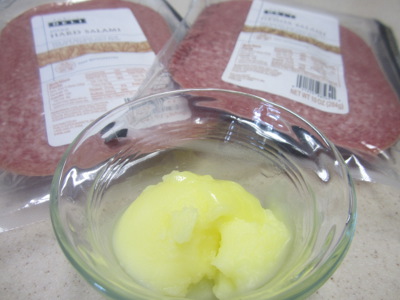
Now, frying salami in schmaltz is something I’ve never tried. (Frying salami in anything, come to think of it.) So, we’re guessing that a couple tablespoons of schmaltz will be enough for all the slices. We’re also trying a couple different types of salami to see which might turn out better.
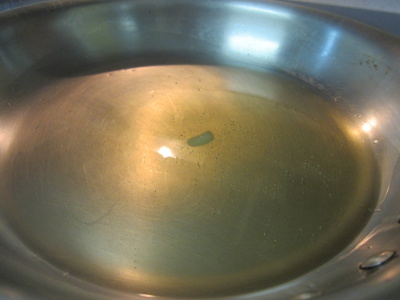
Once the schmaltz was melted, it was time to put in the salami, and I realized I had no idea how this was supposed to work. One slice at a time? All the salami? Keep it flat, or stir it around like bacon?
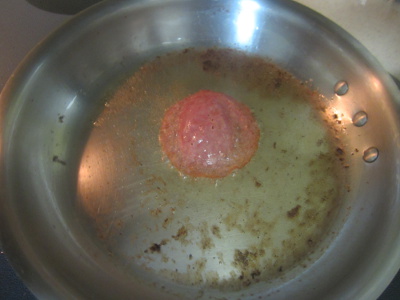
Dropping in a slice, it immediately started to sizzle and crisp up around the edges. Which was really cool and everything, but I couldn’t imagine frying enough salami to feed people if I had to do it one slice at a time. There’s a candy store to run, after all.
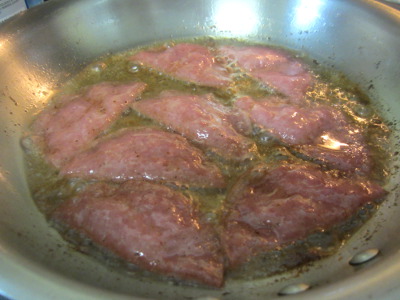
So the next batch was as many slices as we could fit in the pan. That looks more efficient!
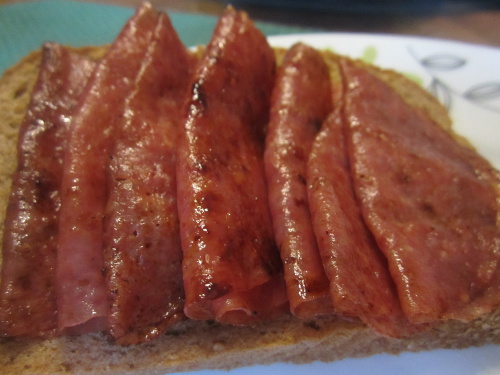
Fried salami is an absurdly greasy food, but it tastes pretty good. The texture is much like bacon, but the flavor isn’t at all smoky. (The choice of salami really doesn’t matter: once it’s fried and crispy you can’t tell much difference.) Piled on bread, add some lettuce and tomato, and yum.
Thinking of her family eating that on a regular basis makes me cringe, though — all those lipids, especially when I’ve also got a lot of death certificates describing arteriosclerosis and other heart problems? But this was an incredibly fun gastro-genealogy experience, and we’re glad we tried it!
I wish I had my Baubie’s shtetl recipes! She died when I was a baby, so I never had her legendary knishes or pickles or tsimmes. Schmaltz, however, is an old world legacy I can do without in lieu of my modern bottle of olive oil.
By: naomusings on October 7, 2013
at 1:16 pm
If for no other reason than the ease of acquiring some, I agree about the olive oil!!!
By: Erica on October 7, 2013
at 1:24 pm
I looked around and I can’t find it online anywhere, which honestly seems weird! But I know that on one or two “Triple D” shows, Guy Fieri has shown chefs / cooks opening what appears to be a 1 pint container of schmaltz to cook with or to add into recipes.
So, out there somewhere it CAN be bought, but darned if I could find it!
The obvious way to acquire some, is to cook a whole bird, and separate the fat from the juice. I was doing that for recipes…long, long, LONG before I ever heard the word schmaltz. I collected it for making chicken gravy or for making soup, and I still do. We fry our Turkey Day turkeys, so there are NO drippings for the stuffing or gravy for dinner. Collecting various chicken fats throughout the year bridges that gap.
And I’m not Jewish in any line of familial relations, so it’s absolutely doable by Gentiles too evidently. Oy, who knew?!
(I have to rat myself out on the chicken skin front…Chicken Skin Front…it sounds like an indy band that college students would listen to…uh, well anyway…waaaaay back when I was a kitchen boss in a restaurant, we would periodically get a request from a patron, for fried, or more often broiled, chicken without the skin. I used to ‘steal’ that skin, season it, flour it and fry it for myself as a snack…before long, there got to be fights over that chicken skin, so much so that I had to start throwing it away to keep the peace in the kitchen oh well…)
By: Schteveo on October 7, 2013
at 10:22 pm
I have belatedly realized that some part of the lack of online schmaltz resources is just that nobody buys fats online — I realized that I’d find it absurd to buy butter by mail-order, so why is chicken fat different? No doubt restaurant supply chains would know where to get some, but given how easy it is to make (even the Gentiles can do it 😉 ) I’m not too worried about doing the research.
By: Erica on October 9, 2013
at 3:30 pm
I’m certain in the past I’ve seen packages of chicken skin and fat to render into schmaltz, in the grocery store (next to gizzards, livers, and hearts).
By: Lassie on October 8, 2013
at 12:31 pm
The availability of schmaltz (or, indeed, chicken skin/fat) is presumably very regional. I know there are a couple stores in New York City where you can get rendered fat, and probably a number of grocery stores in the area that sell skin. But I’m currently living in South Carolina, so there’s no way I’m going to be able to find any!
By: Erica on October 9, 2013
at 3:26 pm
We have Empire chicken fat for sale in Omaha, but it comes frozen and is kind of expensive.
I loved this post. After you fry the salami, you’re supposed to fry eggs in the remaining fat so you can get all the benefits of the salami-seasoned schmaltz. Oh, and serve it with rye toast, that’s required. We always bought the whole salami, then after it was cut let it hang from the handle of a kitchen cabinet until it started to dry out and shrivel a bit. The fat gets concentrated into squishy globs (sorry, I’m at a loss for a better way to describe it).
This really took me back to my Ukrainian grandmother’s apartment in Chicago (she ran a newsstand, which is not unlike a candy store in that the items sold cost only pennies. How people survived the Depression amazes me) that always smelled of rendered chicken fat…and mothballs, but admittedly those are both odours that tend to hang in the air a while.
By: Goody on October 10, 2013
at 12:39 am
Wow, it’s really neat to hear the memories of somebody else who got to experience this kind of (Eastern European/Chicago) cooking. We naturally tried to model our way of cooking after what my great grandmother Lena did. However, there aren’t that many people left alive who really remember her cooking. From talking to her nephew, I got the impression that the salami frying was an ongoing thing, with a few slices in the pan at all times; that way, anybody who happened through the kitchen could grab a freshly sizzled slice to nosh. I’m not sure what they put them on, but rye toast certainly sounds plausible. I suspect Lena didn’t make eggs afterwards, but perhaps she sometimes did.
By: Buzz on October 10, 2013
at 11:02 pm
My grandmother made this, but she used kosher beef salami cut into small cubes. It might be served as an appetizer/snack on toothpicks with deli mustard, or it was breakfast. She would do the salami and then scramble eggs and leftover egg noodles in the salami flavored schmaltz.
By: Ann on October 14, 2013
at 8:25 pm
Sounds tasty — and I bet the cubes were a lot easier to stir!!!
By: Erica on October 14, 2013
at 9:18 pm
I really enjoyed this! I’ve been making my own bone broth/stock for the past several months, and I save all the juices and fat from the whole chickens I roast. The juice/gelatin is an essential ingredient in stock, and I usually throw in a tablespoon or so of the schmaltz for richness. I’ve never known what to do with the rest of the (very small amount of) fat. You’re right — it would take a lot of chickens to get a sizable amount of schmaltz. I bet chickens WERE fatter back then! You can probably buy schmaltz at larger delis, but I’m not sure there are many in my neck of the woods.
By: retroadverto on October 20, 2013
at 11:50 pm
I recently found your site & love it. I have so many old cookbooks & recipes. I love collecting & even more just reading them. When my kids were young they liked picking out “good” ones to try & strange ones to discuss how awful they’d be. I would really like to subscribe & wonder if you’d consider email subscriptions. I didn’t see it here. If not I’ll check in frequently & thanks for my favorite type of reading.
By: cookbkcollector on October 23, 2013
at 5:10 pm
Thanks — they certainly are fun to read, even when they’re not fun to eat! If you look in the very bottom right corner, there should be a small grey “+ Follow” box where you can subscribe by email — let me know if that doesn’t work or you can’t find it.
By: Erica on October 23, 2013
at 6:30 pm
We don’t live in a Jewish neighborhood, but I can get chicken skin just by asking the butcher department of my supermarket. They’re so excited to get somebody to take it off their hands they’ll hand out pounds and pounds of it at 10 cents a pound (and that only because they have to put SOME price when they wrap it up or the machine won’t let them do it).
By: C Baker on June 10, 2014
at 1:23 am
Belatedly: some Publix grocery stores in sort-of-Jewish neighborhoods in South Florida have frozen kosher schmaltz, but I think it’s like $6 for half a pound. Also, the fatty acid content of chicken fat depends on the birds’ diet, so the schmaltz may in effect be largely corn or soybean oil… for decades this would have been thought healthful, but now there’s some doubt (too much omega-6 fatty acid might be bad).
By: Mark. on June 29, 2014
at 7:28 pm